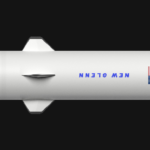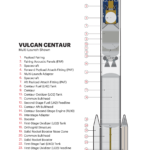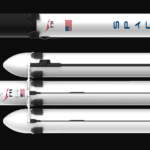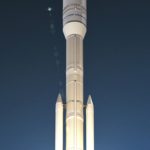SpaceX
DeepSpace: A critical juncture for SpaceX, Blue Origin, ULA, other players

This is a free preview of DeepSpace, Teslarati’s new member-only weekly newsletter. Each week, I’ll be taking a deep-dive into the most exciting developments in commercial space, from satellites and rockets to everything in between. Sign up for Teslarati’s newsletters here to receive a preview of our membership program.
A high-pressure competition between all four major US launch providers – SpaceX, ULA, Blue Origin, and Orbital ATK (now NGIS) – is about to head into its most critical stage, a period of 60 days allotted for interested parties to submit their completed proposals. According to the US Air Force (USAF), the final request for proposals (RFP) could come as early as March 29th, giving the four aforementioned companies until May 28th to complete their proposals.
All things considered, the growing pressure and some of the USAF’s strategy behind the program – known as Launch Service Procurement (LSP) Phase 2 – has raised significant questions that remain largely unanswered and lead to a few mild bouts of strife or unhappiness from contract competitors. Most notably, Blue Origin – having just won a USAF development contract worth $500M – has repeatedly requested that the USAF and Department of Defense (DoD) delay the RFP and contract awards until 2021, according to Space News’ Sandra Erwin. Meanwhile, a lack of clarification from the USAF means that it’s unclear whether the strategy behind launch contract awards (LSP) will end up contradicting or undermining a partially connected development program known as Launch Service Agreements (LSA) that saw the USAF award ~$2B to three providers (excluding SpaceX) between 2018 and 2024.
Battle of the Acronyms: LSP vs. LSA
- Recently rebranded by the US military as the National Security Space Launch (NSSL) program, LSP Phase 1 and 2 and LSA are the latest major procurement initiatives begun under the Evolved Expendable Launch Vehicle (EELV) program, spun up in the 1990s to provide a firmer foundation for the commercial launch of military spacecraft after the 1986 Shuttle Challenger disaster pushed most satellites off of the platform.
- Phase 2 of the EELV program has been ongoing for several years and will culminate with the procurement of 25+ launch contracts (LSP) from two providers no earlier than 2020. The USAF’s Launch Service Agreements are also a major strategic feature of Phase 2, nominally seeing the military branch contribute major funding to assist in the development of three separate launch vehicles (New Glenn, Vulcan, and Omega) with the intention of ultimately certifying those rockets for EELV (now NSSL) launches.
- LSA also saw the USAF award several tens of millions to SpaceX, Blue Origin, and Aerojet Rocketdyne to develop capabilities centered around advanced, new rocket engines (BE-4, AR-1, and Raptor), but the latest phase of LSA is valued at least several times higher than its earlier engine-specific awards.
-
- Oddly, the purpose of LSA was – at least on the cover – to effectively ensure that the Air Force had multiple (more than two) providers and thus preserve a healthy, competitive military launch market. A senior leader specifically stated that “the goal of [LSA] is to make sure [the US military has] a competitive industrial base.”
- Aside from an initial $181M awarded to Blue Origin, ULA, and Orbital ATK (now Northrop Grumman Innovation Systems, NGIS) in 2018 and 2019, the remaining funding – up to $320M for Blue Origin’s New Glenn, $610M for NGIS’ Omega, and $785M for ULA’s Vulcan – would be dispersed to each provider between 2020 and 2024.
- However, an odd and controversial bit of language behind the coming five-year launch services procurement (LSP) initiative would completely cut off funding to LSA awardees in the event that they fail to be awarded launches from the latest LSP.
- Additionally, the LSP awards are strictly meant – apparently very intentionally – to be distrubuted among two launch providers, despite a minimum at least four being able (SpaceX) or required (ULA, Blue, NGIS) to enter a bid.
- In other words, this guarantees that either one or two of the three LSA awardees would have the vast majority of their supposedly awarded development funding cut off after FY2020, four years early.
- Oddly, the purpose of LSA was – at least on the cover – to effectively ensure that the Air Force had multiple (more than two) providers and thus preserve a healthy, competitive military launch market. A senior leader specifically stated that “the goal of [LSA] is to make sure [the US military has] a competitive industrial base.”
- Despite continued protests from a number of stakeholders, the USAF has refused to budge from its decision to simultaneously A) create a duopoly, B) defeat the purpose of LSA awards, and C) mass-award ~25 launch contracts to two providers in 2020, anywhere from 12-24 months prior to the planned inaugural launches of all three LSA-funded rockets.
- Without cost-sharing development funds from the USAF and a chance of winning more than a handful of US military launch contracts between now and the late 2020s, it can be all but guaranteed that an LSA funding cutoff will either indefinitely pause or slow to a crawl a given provider’s development of their proposed launch vehicle.

A rocket and a hard place
- This sticky situation thus offers up a few potential ways that this badly-designed (or entirely dishonest) military launch development and procurement strategy will end up by the end of 2020. One way or another, the current strategy as it stands will end up providing two (or one, given that SpaceX will not receive LSA funding) companies with several years of development funding and at least five years of bountiful, guaranteed launch contracts.
- The four providers and two LSP slots available offer a set range of possible alternate realities, limited by political barriers that would, say, almost invariably prevent the USAF from severely harming ULA by cutting off the vast majority of the company’s only real source of income for 5+ years.
- ULA and SpaceX win: This maintains the status quo, wholly invalidating the point of using LSA funds to ensure “a competitive industrial base.” NGIS likely cancels/freezes all Omega development with no chance of competing in commercial markets. Blue Origin owner Jeff Bezos could significantly delay New Glenn’s readiness for military missions if he fails to invest an additional $500M in infrastructure. Likeliest result: a marginally competitive duopoly.
- ULA wins, SpaceX loses: Having just certified Falcon 9 – and nearly Falcon Heavy – for high-value military launches and awarded SpaceX a total of 10 launch contracts (9 yet to be completed), the USAF could effectively spit in SpaceX’s face and award ULA and Blue Origin or NGIS LSP’s 25+ launch contracts.
- It’s hard to exaggerate just how much of a slight this would be perceived as by SpaceX and its executives, CEO Elon Musk in particular. The USAF would be risking the creation of a major political enemy, one which has already demonstrated a willingness to take the federal government to court and win. The USAF/DoD would effectively be hedging their bets against an assumption that SpaceX’s nine present military launch contracts will sate the company and ensure that SpaceX indefinitely remains a certified EELV/NSSL provider.
- In this eventuality, either Blue Origin or NGIS would lose LSA funding and the prospect of almost any military launch contracts until the late 2020s. For NGIS, this would likely kill Omega.
- At the end of the day, it’s sadly conceivable that the USAF/DoD may end up awarding LSP contracts to ULA (effectively a politically-forced hand) and NGIS, the latter assuring Omega’s survival. The military would thus be assuming that the political fallout created with SpaceX and Blue Origin would not be enough to severely harm their relationships, while also assuming that their much stronger commercial prospects and independent funding sources would ensure that each provider remains certified and willing to compete for future NSSL/EELV launches.
Regardless of what happens, the contradictory ways the USAF/DoD have structured their LSA and LSP programs seems bizarrely intent on creating major headaches and potential problems where that could easily be avoided with extraordinarily simple changes, namely removing the inexplicable cap and allowing three or more companies to win some of the ~25 LSP launch contracts).
Mission Updates
- The second launch of Falcon Heavy – the rocket’s commercial debut – is still scheduled to occur as early as April 7th.
- After Falcon Heavy, Cargo Dragon’s CRS-17 resupply mission is firmly scheduled for April (April 25th), while the first dedicated Starlink launch is now NET May 2019.
Photo of the Week:

SpaceX CEO Elon Musk offered a glimpse of a 1650 Kelvin (2500ºF/1400ºC) test of Starship’s metallic heat shield, simulating mid-range temperatures such a shield’s windward side might experience during an orbital-velocity reentry.(c. Elon Musk/SpaceX)

Elon Musk
Starlink achieves major milestones in 2025 progress report
Starlink wrapped up 2025 with impressive growth, adding more than 4.6 million new active customers and expanding service to 35 additional countries, territories, and markets.

Starlink wrapped up 2025 with impressive growth, adding more than 4.6 million new active customers and expanding service to 35 additional countries, territories, and markets. The company also completed deployment of its first-generation Direct to Cell constellation, launching over 650 satellites in just 18 months to enable cellular connectivity.
SpaceX highlighted Starlink’s impressive 2025 progress in an extensive report.
Key achievements from Starlink’s 2025 Progress
Starlink connected over 4.6 million new customers with high-speed internet while bringing service to 35 more regions worldwide in 2025. Starlink is now connecting 9.2 million people worldwide. The service achieved this just weeks after hitting its 8 million customer milestone.
Starlink is now available in 155 markets, including areas that are unreachable by traditional ISPs. As per SpaceX, Starlink has also provided over 21 million airline passengers and 20 million cruise passengers with reliable high-speed internet connectivity during their travels.
Starlink Direct to Cell
Starlink’s Direct to Cell constellation, more than 650 satellites strong, has already connected over 12 million people at least once, marking a breakthrough in global mobile coverage.
Starlink Direct to Cell is currently rolled out to 22 countries and 6 continents, with over 6 million monthly customers. Starlink Direct to Cell also has 27 MNO partners to date.
“This year, SpaceX completed deployment of the first generation of the Starlink Direct to Cell constellation, with more than 650 satellites launched to low-Earth orbit in just 18 months. Starlink Direct to Cell has connected more than 12 million people, and counting, at least once, providing life-saving connectivity when people need it most,” SpaceX wrote.
Elon Musk
Starlink passes 9 million active customers just weeks after hitting 8 million
The milestone highlights the accelerating growth of Starlink, which has now been adding over 20,000 new users per day.

SpaceX’s Starlink satellite internet service has continued its rapid global expansion, surpassing 9 million active customers just weeks after crossing the 8 million mark.
The milestone highlights the accelerating growth of Starlink, which has now been adding over 20,000 new users per day.
9 million customers
In a post on X, SpaceX stated that Starlink now serves over 9 million active users across 155 countries, territories, and markets. The company reached 8 million customers in early November, meaning it added roughly 1 million subscribers in under seven weeks, or about 21,275 new users on average per day.
“Starlink is connecting more than 9M active customers with high-speed internet across 155 countries, territories, and many other markets,” Starlink wrote in a post on its official X account. SpaceX President Gwynne Shotwell also celebrated the milestone on X. “A huge thank you to all of our customers and congrats to the Starlink team for such an incredible product,” she wrote.
That growth rate reflects both rising demand for broadband in underserved regions and Starlink’s expanding satellite constellation, which now includes more than 9,000 low-Earth-orbit satellites designed to deliver high-speed, low-latency internet worldwide.
Starlink’s momentum
Starlink’s momentum has been building up. SpaceX reported 4.6 million Starlink customers in December 2024, followed by 7 million by August 2025, and 8 million customers in November. Independent data also suggests Starlink usage is rising sharply, with Cloudflare reporting that global web traffic from Starlink users more than doubled in 2025, as noted in an Insider report.
Starlink’s momentum is increasingly tied to SpaceX’s broader financial outlook. Elon Musk has said the satellite network is “by far” the company’s largest revenue driver, and reports suggest SpaceX may be positioning itself for an initial public offering as soon as next year, with valuations estimated as high as $1.5 trillion. Musk has also suggested in the past that Starlink could have its own IPO in the future.
News
SpaceX shades airline for seeking contract with Amazon’s Starlink rival

SpaceX employees, including its CEO Elon Musk, shaded American Airlines on social media this past weekend due to the company’s reported talks with Amazon’s Starlink rival, Leo.
Starlink has been adopted by several airlines, including United Airlines, Qatar Airways, Hawaiian Airlines, WestJet, Air France, airBaltic, and others. It has gained notoriety as an extremely solid, dependable, and reliable option for airline travel, as traditional options frequently cause users to lose connection to the internet.
Many airlines have made the switch, while others continue to mull the options available to them. American Airlines is one of them.
A report from Bloomberg indicates the airline is thinking of going with a Starlink rival owned by Amazon, called Leo. It was previously referred to as Project Kuiper.
American CEO Robert Isom said (via Bloomberg):
“While there’s Starlink, there are other low-Earth-orbit satellite opportunities that we can look at. We’re making sure that American is going to have what our customers need.”
Isom also said American has been in touch with Amazon about installing Leo on its aircraft, but he would not reveal the status of any discussions with the company.
The report caught the attention of Michael Nicolls, the Vice President of Starlink Engineering at SpaceX, who said:
“Only fly on airlines with good connectivity… and only one source of good connectivity at the moment…”
CEO Elon Musk replied to Nicolls by stating that American Airlines risks losing “a lot of customers if their connectivity solution fails.”
American Airlines will lose a lot of customers if their connectivity solution fails
— Elon Musk (@elonmusk) December 14, 2025
There are over 8,000 Starlink satellites in orbit currently, offering internet coverage in over 150 countries and territories globally. SpaceX expands its array of satellites nearly every week with launches from California and Florida, aiming to offer internet access to everyone across the globe.
Currently, the company is focusing on expanding into new markets, such as Africa and Asia.














